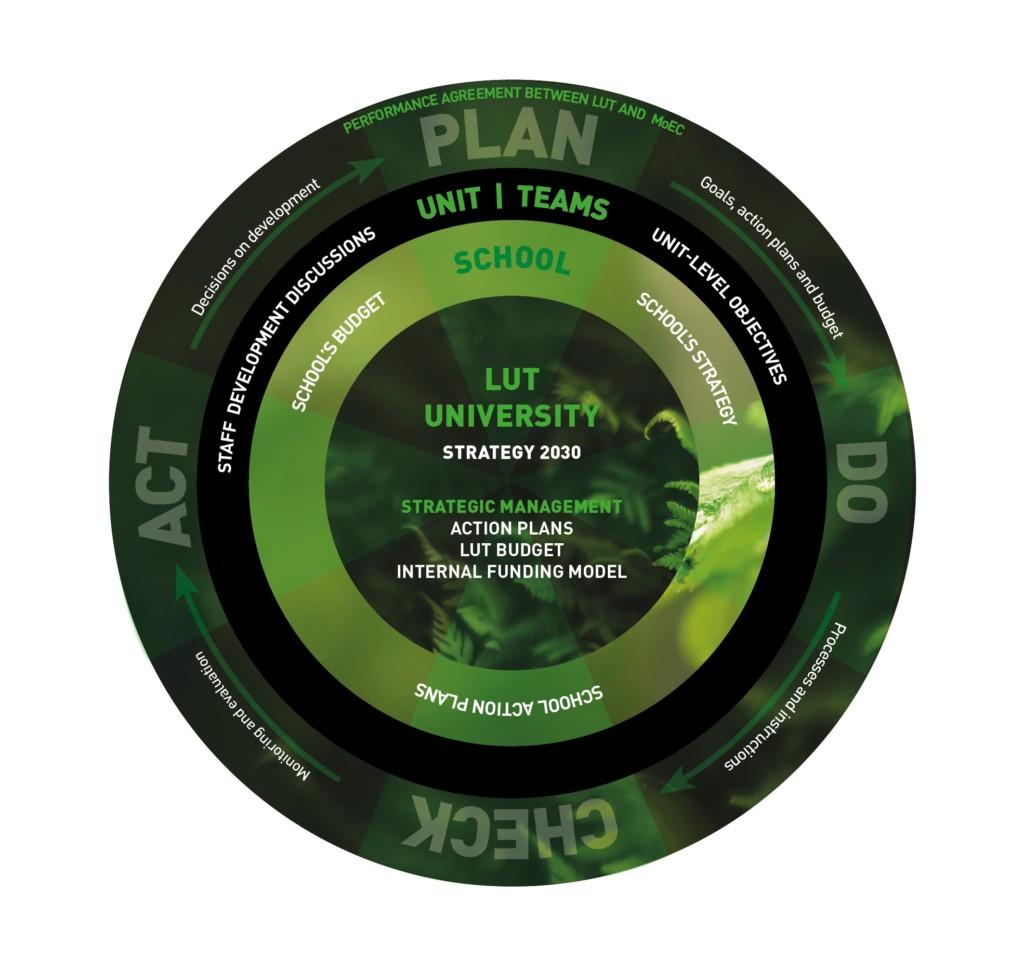Quality management and strategic management have the same target
The purpose of LUT’s Quality Management System (QMS) is to support the achievement of the university’s strategic goals and to assure the high quality of the university’s operations and results. The QMS supports the university management and ensures the continuous development of its functions in accordance with the university’s quality policy and the PDCA cycle. The QMS is described in the quality manual published on the LUT website. The LUT intranet contains more detailed information on the QMS for internal stakeholders. Both the LUT website and intranet will be renewed in the near future: the website in 2021 and the intranet in 2023-24.
Figure 7. The interaction between quality and strategic management
QMS promotes the evidence based development of core functions
The quality management system supports the performance and continuous improvement of the university’s core functions by ensuring that their goals, responsibilities, instructions, monitoring procedures and results are defined and communicated in a way that serves both internal and external stakeholders. The monitoring and analysis of the performance of core operations have been significantly strengthened in recent years at all organisational levels of LUT, providing a solid basis for strategic management and the continuous improvement of core functions.
For example, LUT has developed a programme portfolio with several digital master’s programmes based on the results of student admission and progress. LUT has also promoted the release of high-quality research publications through intensive monitoring of publishing activities and an incentive system for researchers. The challenge of monitoring performance is the fragmentation of information and information production, for which a data warehouse project has been launched in 2020.
Strategy work relies on information produced by QMS
Strategy work has a significant role in the administration of the university. It has defined the university’s profile among international research universities and how LUT pursues its goals. For the preparation of the strategy, the information produced by the QMS has been crucial e.g. in profiling the core scientific competence of LUT’s researchers and providing information on the performance of core functions, stakeholder feedback and external evaluations. The Research and Impact Assessment in 2019 provided an important background for strategy work.
Strategy work is an example of continuously developing processes. In the latest FINEEC audit, LUT received critical feedback concerning the communication of strategic action plans. On the strategy round in 2020, communication was taken into consideration more thoroughly.
Internal communication and supervisors in crucial role in strategy implementation
Strategy communication has been one of the top priorities of LUT administration. On the preparation phase, a strategy survey, workshops and blogs on the intranet made the ongoing strategy work visible to all. Once the new strategy was confirmed by the board, it was communicated in many ways, e.g. in unit specific strategy sessions. Supervisors of teams are in a crucial position in discussing the strategic goals and their implementation in the team. Performance and development discussions between top management and schools and between employees and supervisors ensure that the unit/team and each of its members observe the strategy. Strategy implementation is also supported by the internal funding model. Since the university now operates on two campuses, it has been recognised that the visibility and communication of administration needs to be strengthened on both campuses.
QMS supports the implementation of the strategy
Quality management supports strategic management by integrating the strategic goals into the QMS. New operating models established through strategic development are included in the university’s normal operations, and the responsibilities, guidelines and evaluation procedures are defined as part of the QMS. In the previous strategy period, for example, the research platform process and the operating and evaluation model of an entrepreneurial university were developed and established. Since 2010, the internationalisation of the university has been an inclusive strategic aim and profiling target. The QMS has supported the development through international accreditations in education development, participation in international university rankings, and a bilingual intranet.
| Strengths | Enhancement areas |
| A concise and focused strategy based on intensive competence analysis | Strategy communication in the transition to a dual-campus model |
| A close link between strategy work and quality work | Availability of relevant and applicable monitoring information in a changing operating environment |
| Addressing emerging development needs and seeking new solutions | Data warehouse to improve foresight by combining, analysing and utilising data from different sources |